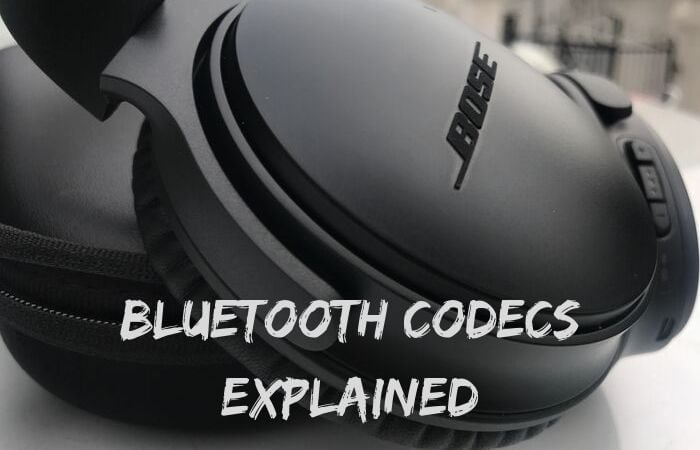Before we delve straight into Codecs, here are a few things you need to know beforehand—
- Sampling rate – measured in hertz (Hz), it is defined as the number of samples (per second) taken from a continuous signal to form a digital signal. The more the number of samples, the more accurate the digital representation is. In layman terms, these samples are screenshots of an audio or video signal at very short intervals, usually tens/thousands of times per second.
- Bit rate – describes the rate at which a bit is transferred between locations. In simpler terms, a bit rate is the amount of data transmitted per unit time. Its unit of measurement is kbps (kilobits per second).
- Bit depth – measured in bits, and defined as the amount (number of bits) of information available for each sample. Generally, the higher the bit depth, the higher the audio quality. With that out of the way, let’s understand what a Codec is, and what are some of the most commonly used Codecs. A Bluetooth Codec is a piece of software (or hardware) that determines how an audio file is transmitted (over Bluetooth) from its source to a piece of audio equipment. It is responsible for encoding digital audio data (at one end) and decoding it (at the other end) into a specific format for faster and reliable wireless transmission. As a reason, the efficiency of a codec plays a crucial role in determining the quality and rate at which the audio data is sent over Bluetooth. Some of the most common Bluetooth Codecs include:
SBC (Sub-Band Coding) AAC (Advanced Audio Coding) LDAC aptX
1. SBC (Sub-Band Coding)
Sub-Band Codec, also referred to as low-complexity subband codec is a digital audio codec for Advanced Audio Distribution Profile (A2DP), and the default codec for a wide range of devices. It is designed to offer reasonably good quality audio at medium bitrates, considering the limited bandwidth and processing power, without adding much complexity. Essentially, SBC takes a signal, divides it into multiple separate frequency bands, and then encodes them individually. It is a lossy compression algorithm and supports a maximum bit rate of around 328kbps at a sampling rate of up to 48kHz, which in turn, results in loss of data. And as a result, the codec fails to provide a high-fidelity audio experience and induces some audio-video delay (or latency) during the transmission.
2. AAC (Advanced Audio Coding)
AAC is a popular audio coding standard, specifically for lossy digital audio compression, and also the default format for Apple devices and a license-free preferred standard for YouTube and Sony Playstation. It is a successor to the popular audio format, MP3, and also a part of MPEG-2 and MPEG-4 specifications. Compared to MP3, AAC manages to achieve better audio quality at the same (or similar) bit rate than MP3. Most commonly, the bit rate includes 128kbps, 192kbps, or 256kbps. A trade-off with AAC for its better and improved audio quality (over MP3), is compatibility. As mentioned, the AAC format, unlike the MP3 or SBC, is only supported on a handful of devices from select manufacturers. Due to this, a large demographic that uses other products, say Android (for instance), can not utilize the codec to its full potential. Thus, sacrificing some audio quality.
3. LDAC
LDAC is a popular codec standard developed by Sony and competes with the likes of aptX and LHDC. It is a lossy codec that uses the hybrid coding scheme to offer a more efficient audio compression, with up to 990kbps of bit rate at 96kHz. Since a lot of smartphones stream audio at 320kbps, users need to change it to a higher bit rate manually from the developer settings. Despite being Sony’s proprietary codec, starting Android Oreo, the LDAC codec has been included as a part of AOSP (Android Open Source Project) to allow other OEMs to integrate it on their devices and take advantage of the improved audio quality.
4. aptX
Developed by Qualcomm, aptX is a family of codecs for digital audio compression that holds a wide range of advantages over some of the other codecs. The family includes aptX, aptX HD, aptX Live, Enhanced aptX, aptX Adaptive, and aptX Low Latency, with each offering some unique benefit over the other. Starting with the regular aptX, the codec offers 352kbps of bit rate at 48kHz sampling rate, whereas, the aptX HD provides 576kbps with 48kHz. Among the different variants of aptX, the aptX Low Latency offers the lowest latency that sits at less than 40ms, making it one of the preferred choices when it comes to audio-video synchronization.
Conclusion
Despite playing a crucial role in deciding audio quality, it is necessary for both – the device you are playing music on and the headphones (or earphones) you are listening on – to support and be on the same Codec. For example, if you have a pair of headphones that support aptX, but your streaming device does not offer support for that codec, it defaults back to its standard format. And as a result, you end up with mediocre audio experience, which is not something that you expect out of your expensive headphones. In a similar vein, if your streaming device supports a high-res codec, but your headphones don’t, the experience would be vanilla, as the headphones will cause the streaming device to default back to the format that it supports. It is, therefore, worth noting that even though the Codec used on a device determines the audio experience to a great extent, other factors like DAC (Digital-to-Analog Converter) and Audio File Formats also play a crucial role in offering an immersive and satisfying audio experience. Albeit that comes with a price, most people, in their day-to-day scenarios, won’t find the difference in audio discerning enough to splurge large sum of money on high-quality headphones and hi-fi music streaming services.









